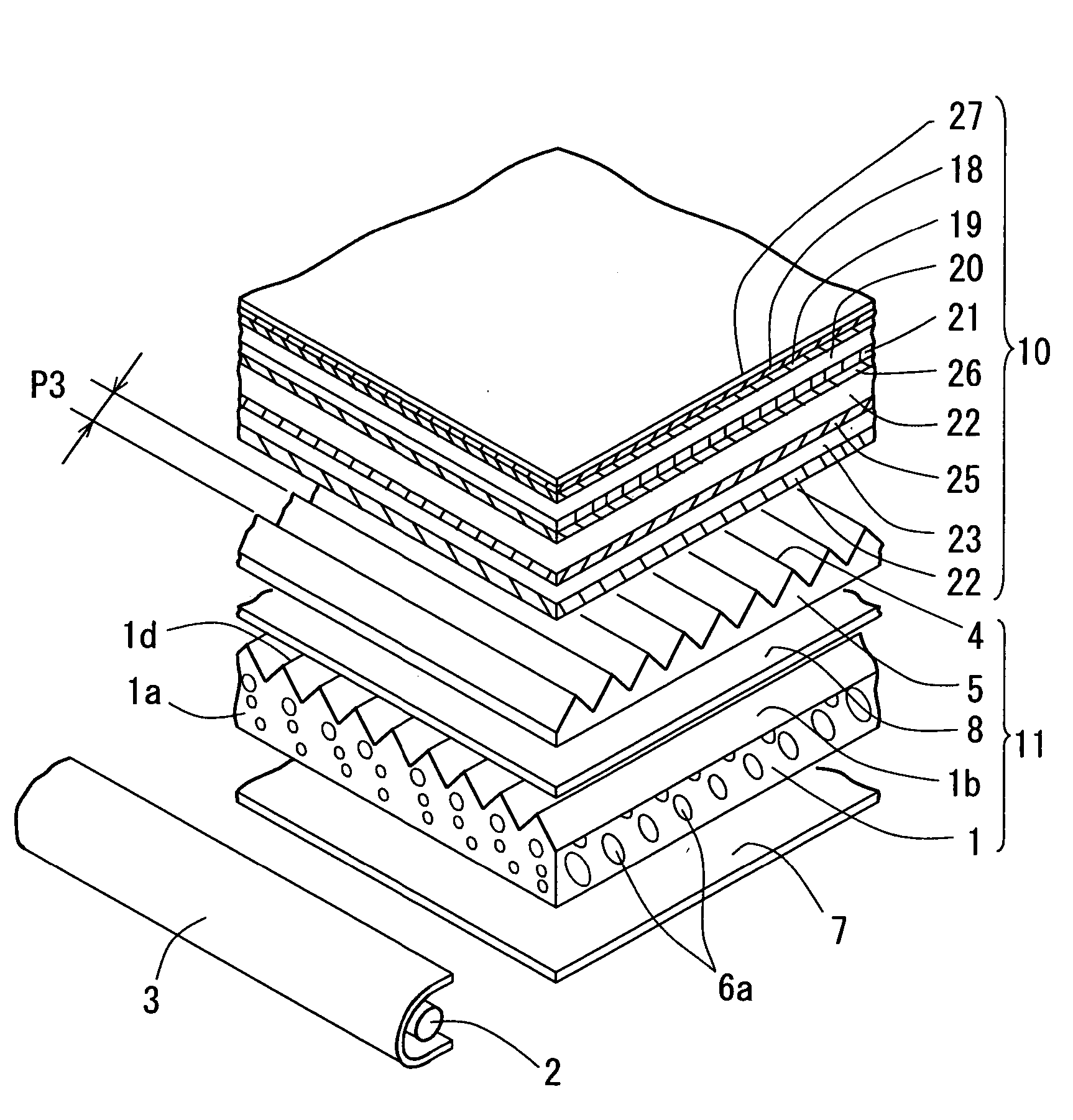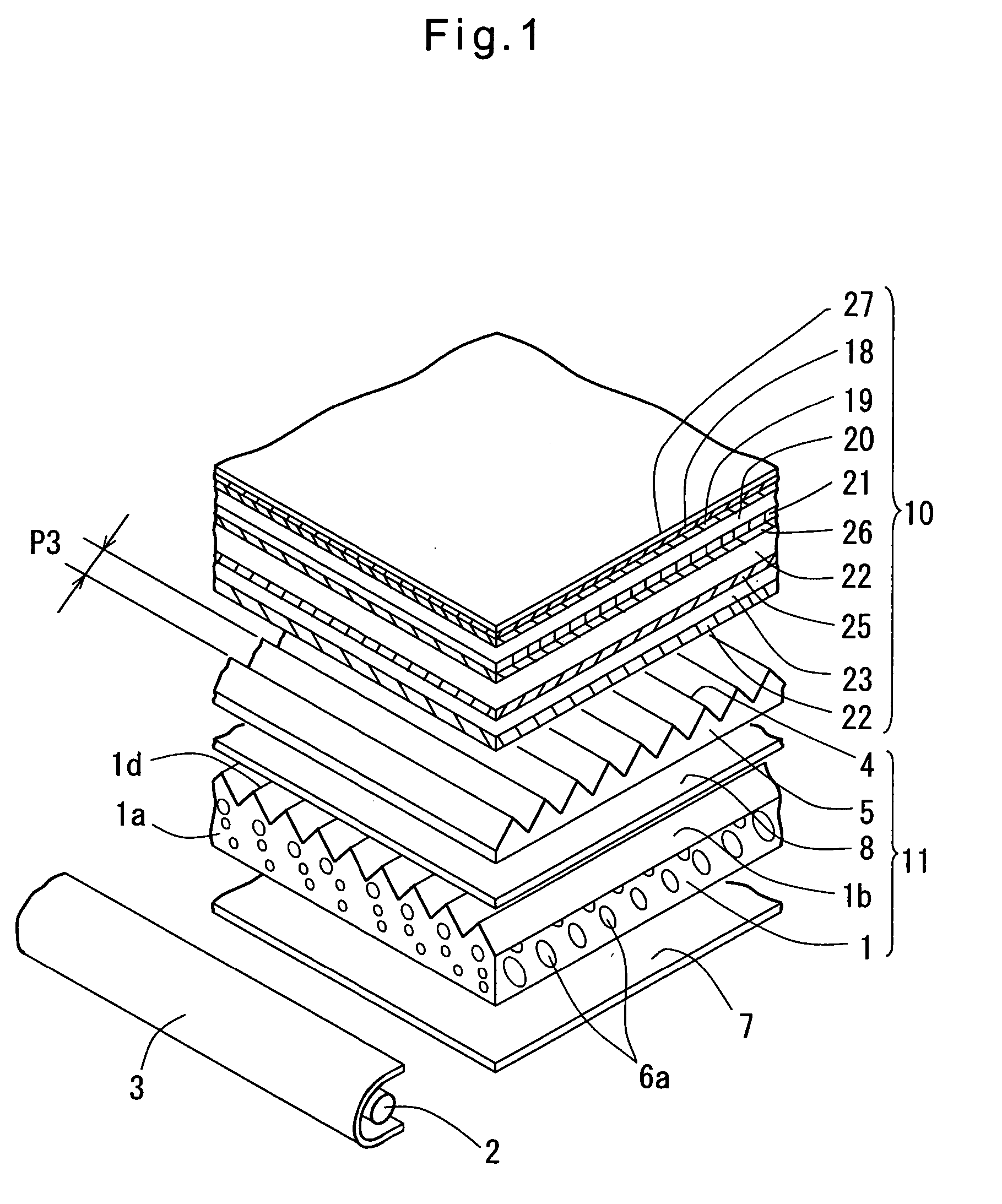Display apparatus
a liquid crystal display and display device technology, applied in the direction of diffusing elements, instruments, optical elements, etc., can solve the problems of insufficient vividness of images, inherently difficult to obtain high color purity, and insufficient vividness of colors, so as to achieve superior design, increase color reproducible range, and high emission efficiency
- Summary
- Abstract
- Description
- Claims
- Application Information
AI Technical Summary
Benefits of technology
Problems solved by technology
Method used
Image
Examples
example 1
(Example 1)
Using a biaxially stretched polyethylene terephthalate film (PET film made by Mitsubishi Polyester Film Corporation, thickness: 100 micrometers) as a substrate 31, in order to form a surface layer having light diffusibility, a coating liquid was prepared by mixing, into a 30 wt % toluene solution of polymethylmethacrylate resin (DIANAL BR-80 made by Mitsubishi Rayon Co., Ltd.), which is a binder resin, spherical beads having an average particle diameter of 27 micrometers and made of acrylic resin by 200 wt % with respect to the binder resin, diphenylsquarylium compound represented by a general formula (I-34) by 0.130 wt % with respect to the binder resin, and pyrazol-family squarylium compound expressed by a general formula (III-3) by 0.040 wt % with respect to the binder resin.
The coating liquid was applied by bar-coating method and dried. After uniformly applying it at a weighed amount of 5.4 g / m2 (as converted to the binder resin), the solvent was dried to obtain a ...
example 2
(Example 2)
Using a commercial iodine-family polarized film (transmittance: 44%, degree of polarization: 99.9%) as a substrate, a coating liquid was prepared by mixing a diphenyl squarylium-family compound expressed by formula (I-35) of [Chemical formula 2] and pyrazol-family squarylium compound expressed by formula (III-3) of [Chemical formula 13] by 0.190 wt % and 0.053 wt %, respectively, relative to the binder resin content into a 30 wt % toluene solution of polymethylmethacrylate resin (DIANAL BR-80 made by Mitsubishi Rayon) as the binder resin, and the coating liquid was applied by bar-coating method, and dried. After uniformly coating at a weighed amount of 5.4 g / m2 (converted to binder resin content), the solvent was dried to obtain a color material-dispersed layer of organic color materials.
As shown in FIG. 1, the polarized film (sign 19) having the color material-dispersed layer (sign 18) was stuck on the front side of a transmission type active matrix-driven twisted nem...
example 3
(Example 3)
Using a biaxially oriented polyethylene terephthalate film (PET film made by Mitsubishi Polyester Film Corporation, thickness: 100 μm) as a substrate, in order to form a surface layer having a light-diffusing layer, a coating solution was prepared by mixing acrylic resin spherical beads having an average particle diameter of 35 μm, tetraazaporphyrin-family compound expressed by formula (II-1) of [Chemical formula 11], and pyrazol-family squarylium compound expressed by formula (III-3) of [Chemical formula 13] by 130 wt %, 0.105 wt % and 0.040 wt %, respectively, relative to a binder resin content into a 20 wt % dimethoxyethane solution of polymethyl methacrylate resin (DIANAL BR-80 made by Mitsubishi Rayon) as the binder resin.
The coating solution was coated by bar-coating method, dried. After uniformly coating at a weighed amount of 5.9 g / m2 (converted to binder resin content), the solvent was dried to obtain a color material-dispersed layer having light diffusion by ...
PUM
| Property | Measurement | Unit |
|---|---|---|
| thickness | aaaaa | aaaaa |
| half band width | aaaaa | aaaaa |
| light absorption half band width | aaaaa | aaaaa |
Abstract
Description
Claims
Application Information
 Login to View More
Login to View More - R&D
- Intellectual Property
- Life Sciences
- Materials
- Tech Scout
- Unparalleled Data Quality
- Higher Quality Content
- 60% Fewer Hallucinations
Browse by: Latest US Patents, China's latest patents, Technical Efficacy Thesaurus, Application Domain, Technology Topic, Popular Technical Reports.
© 2025 PatSnap. All rights reserved.Legal|Privacy policy|Modern Slavery Act Transparency Statement|Sitemap|About US| Contact US: help@patsnap.com



